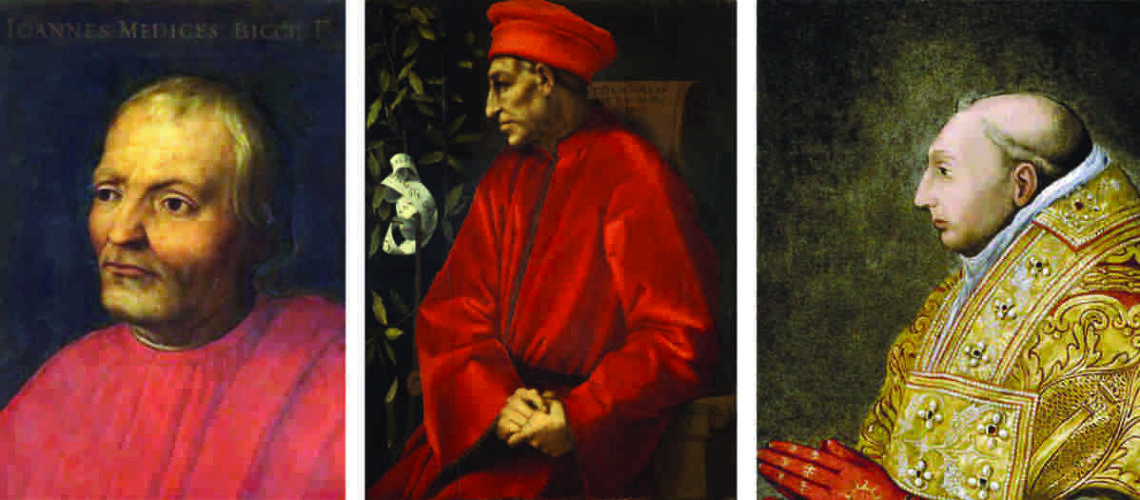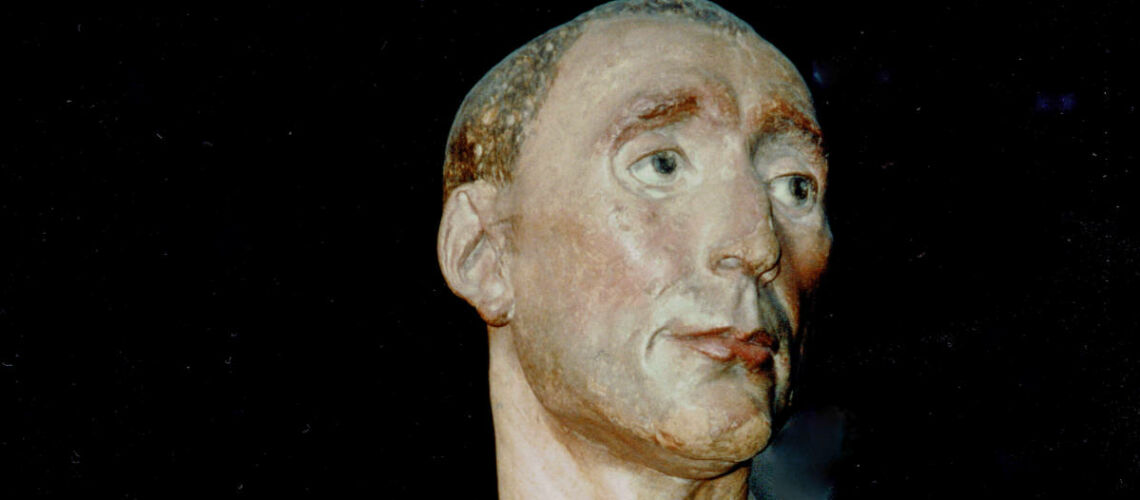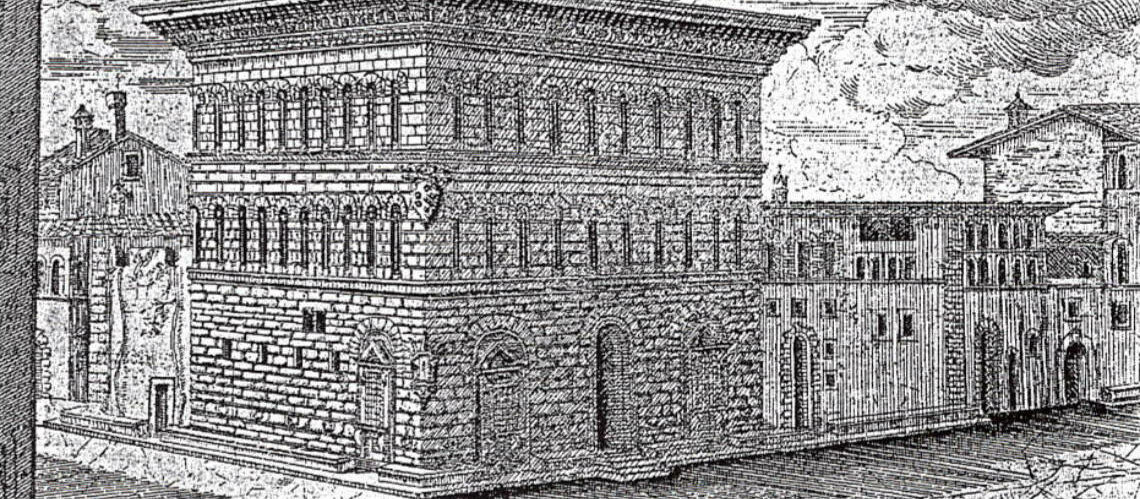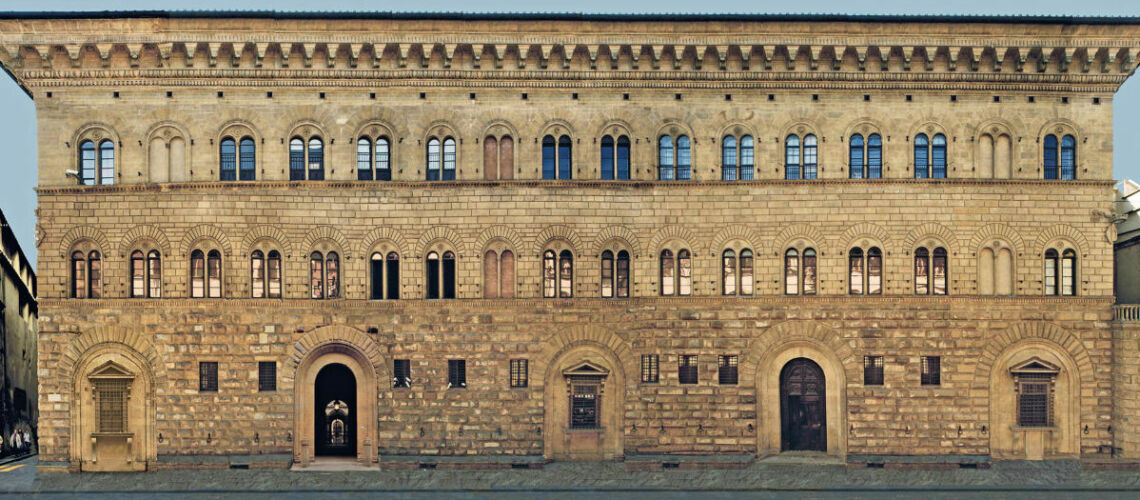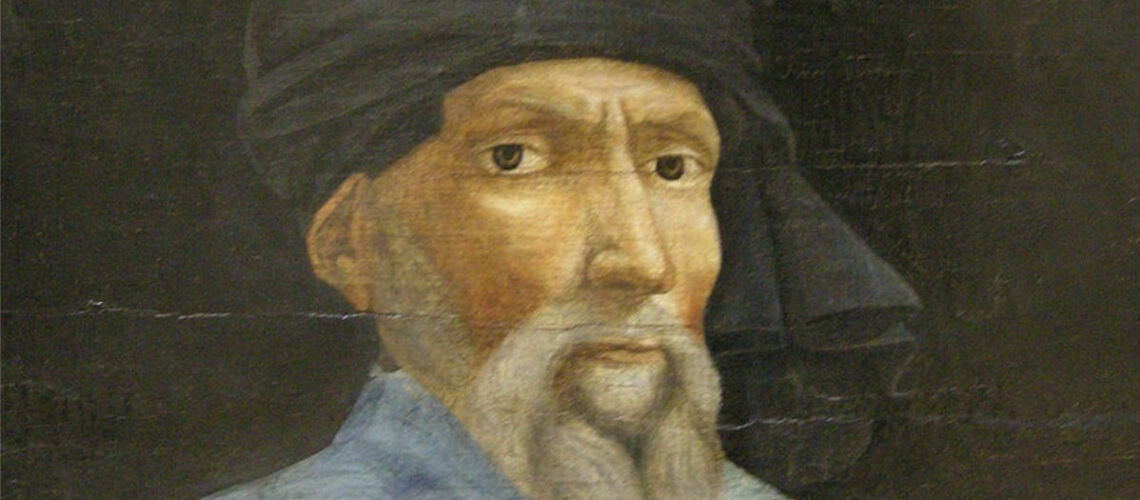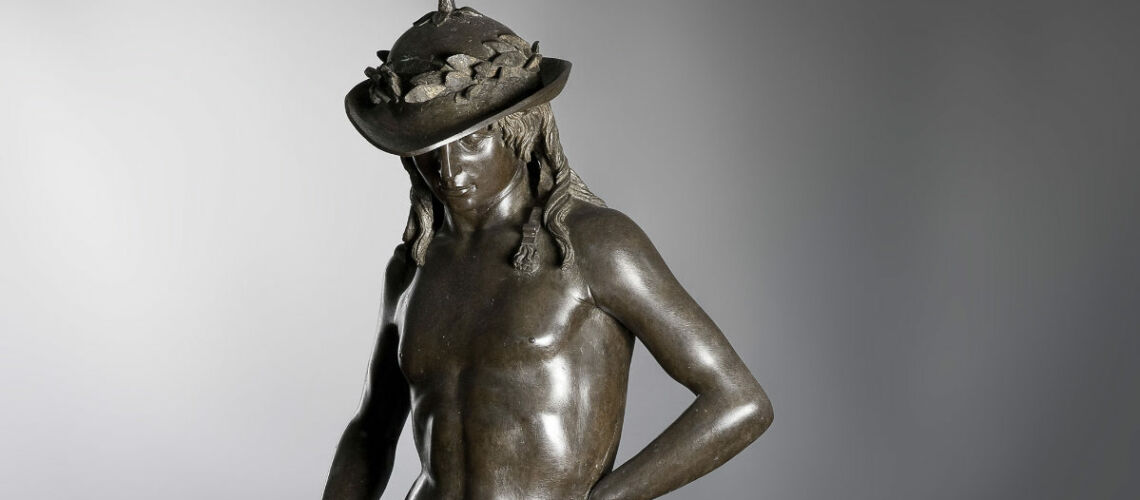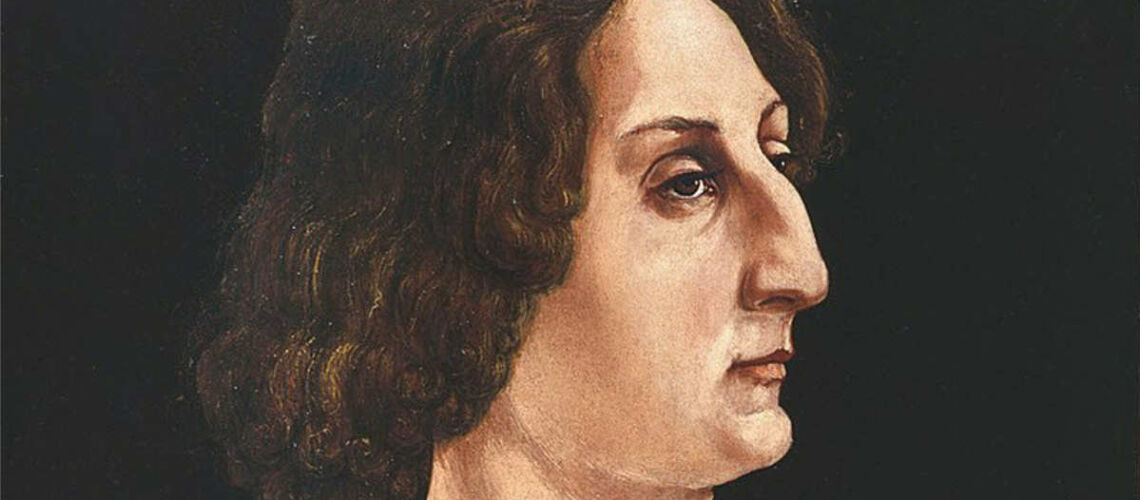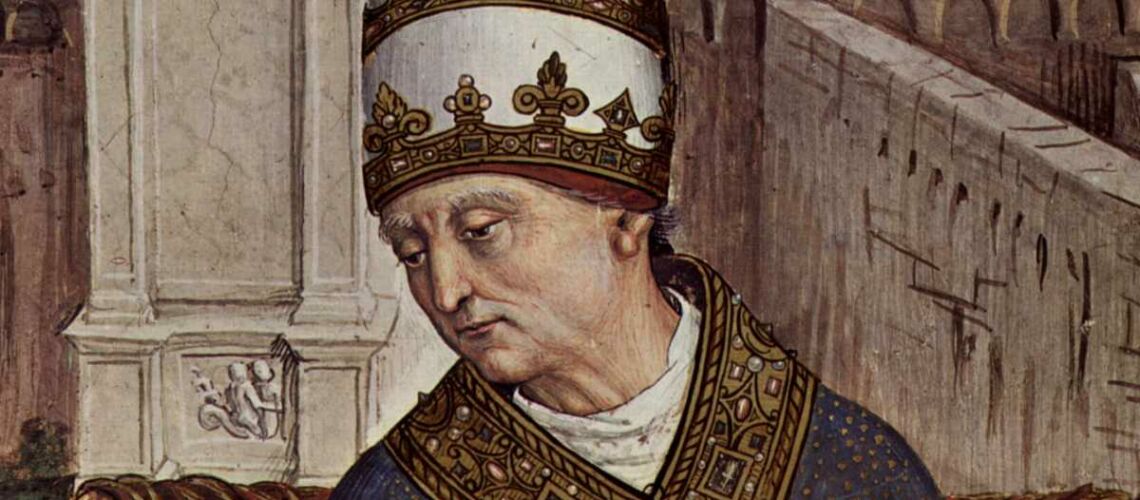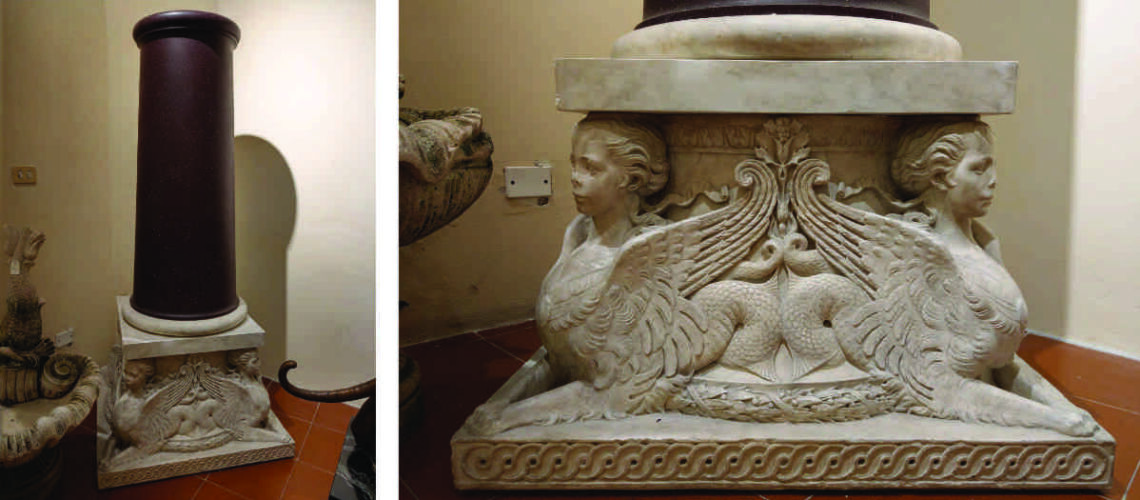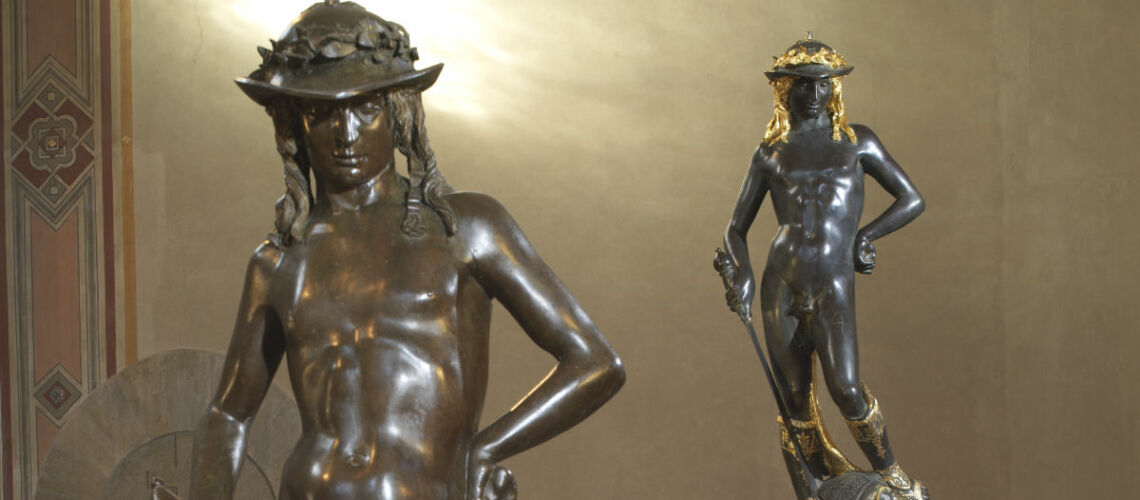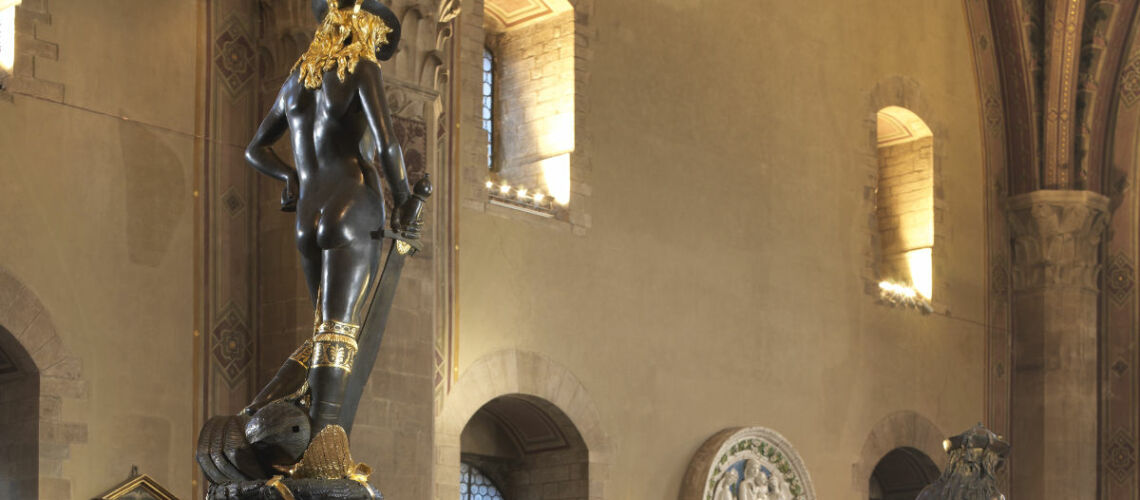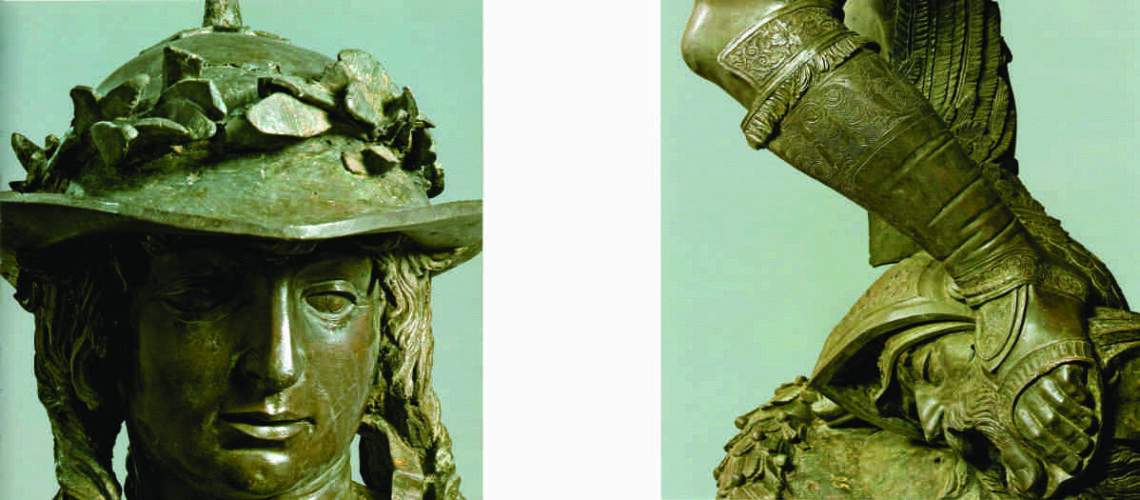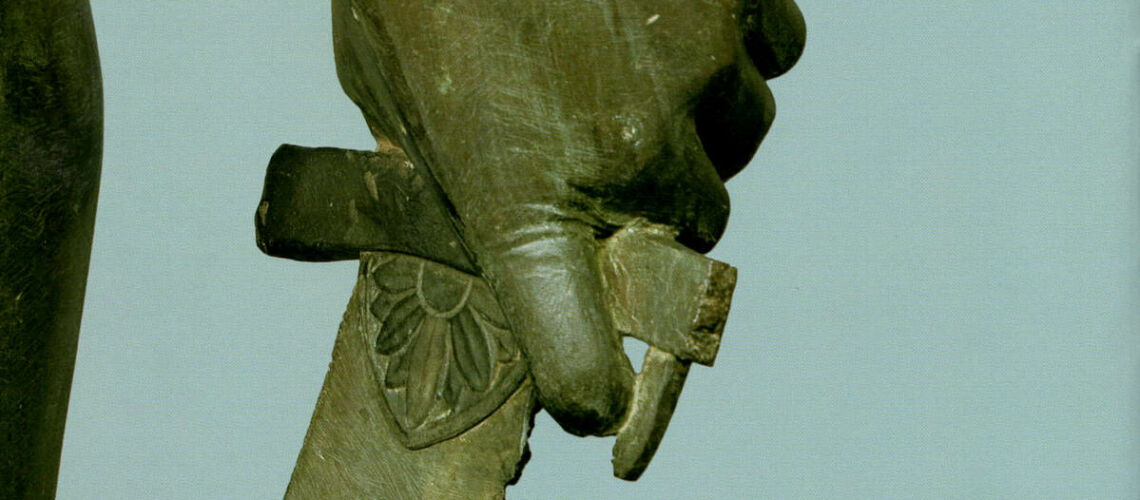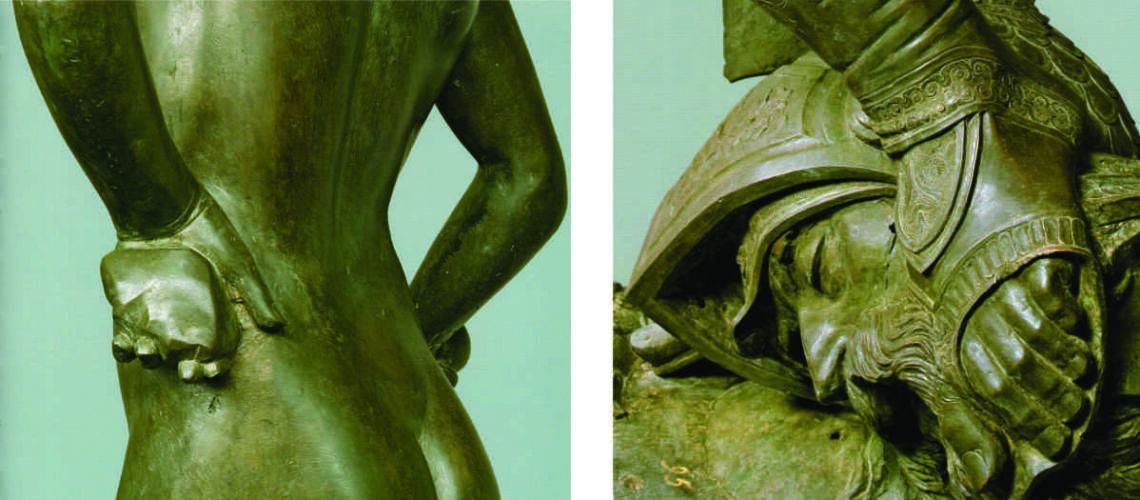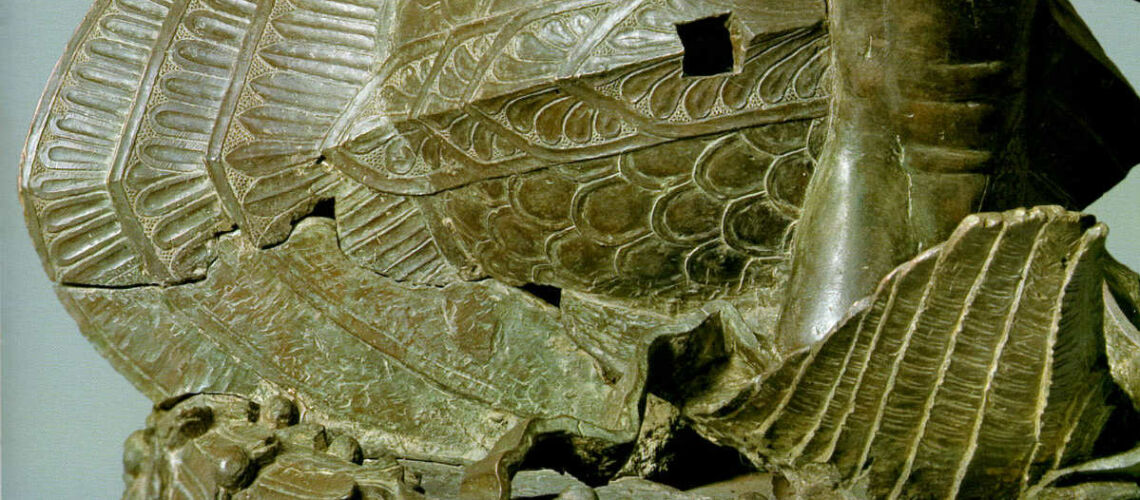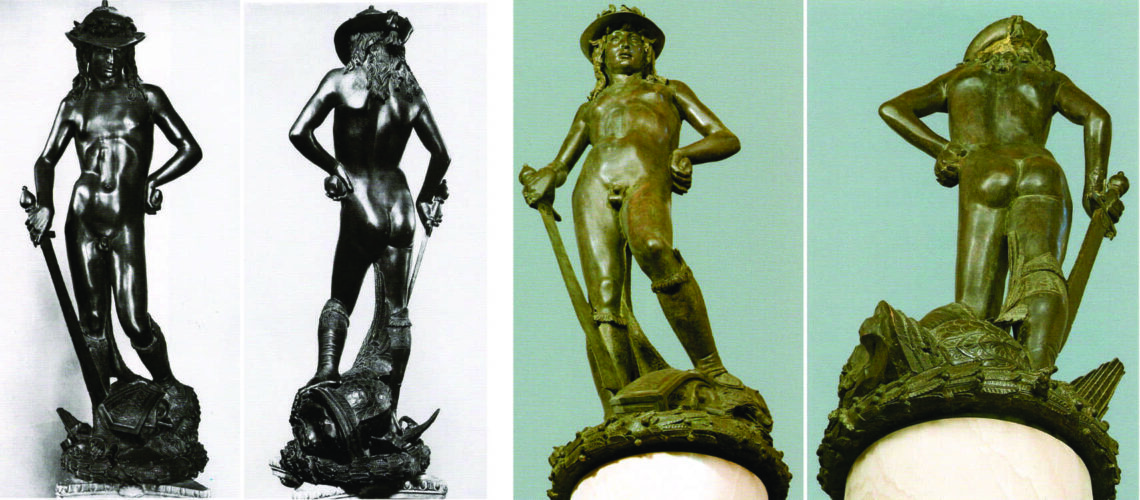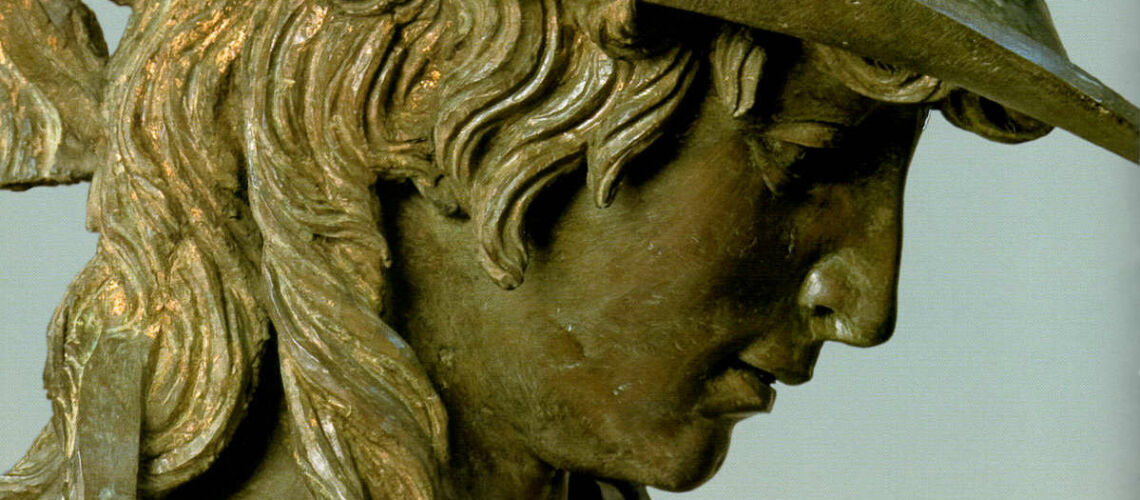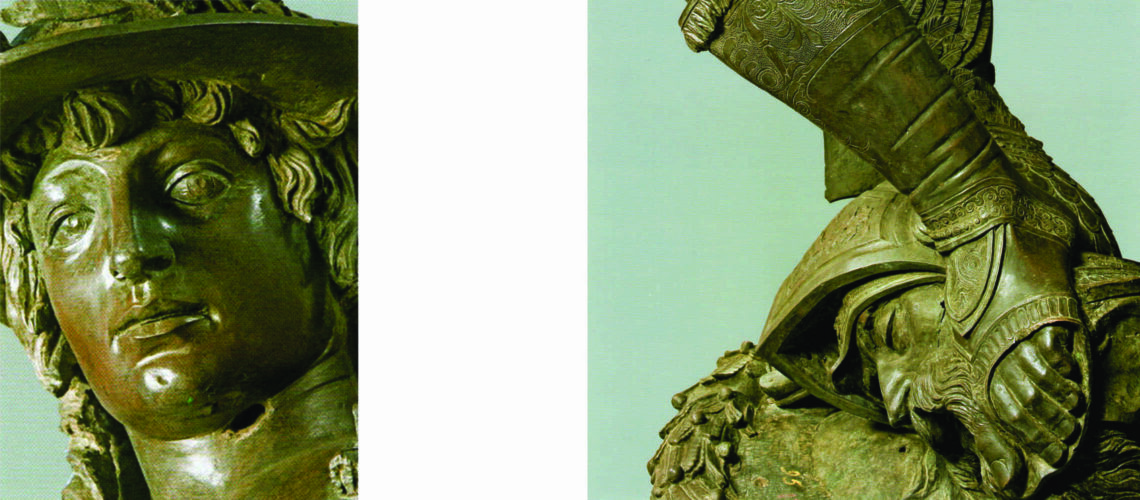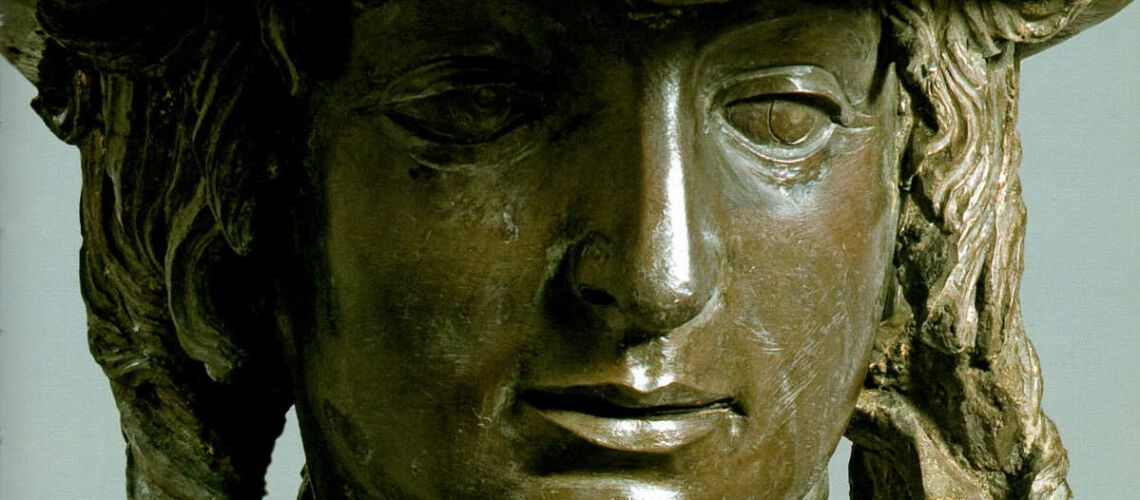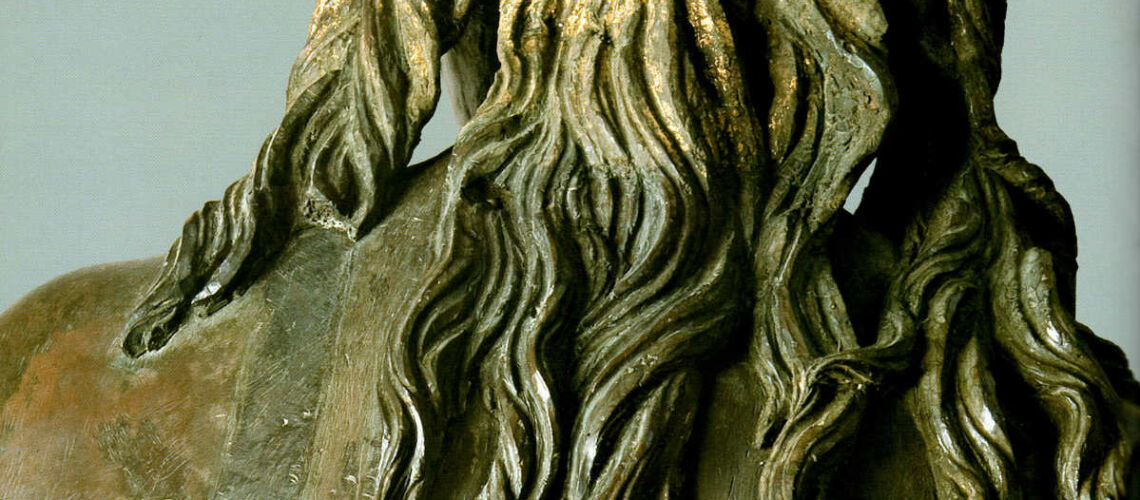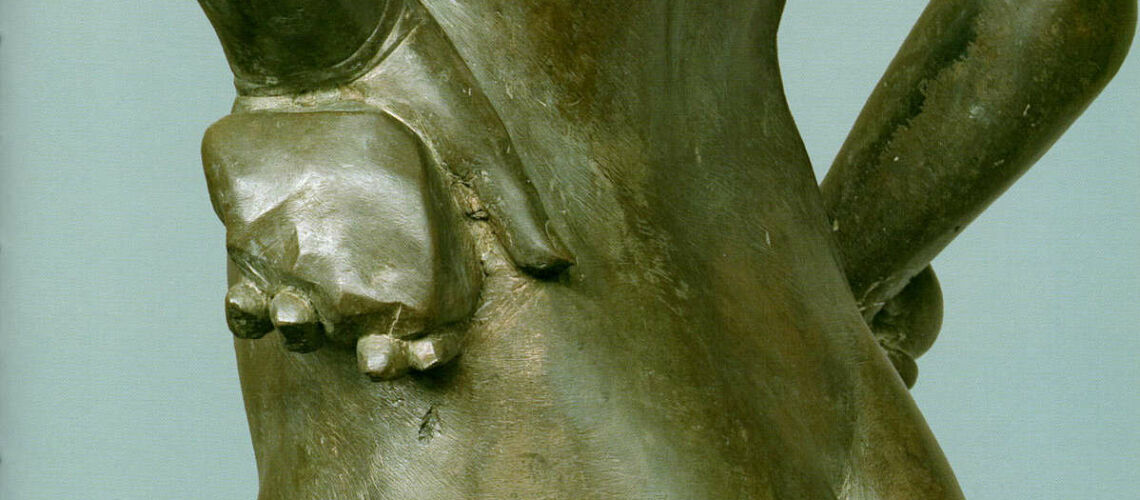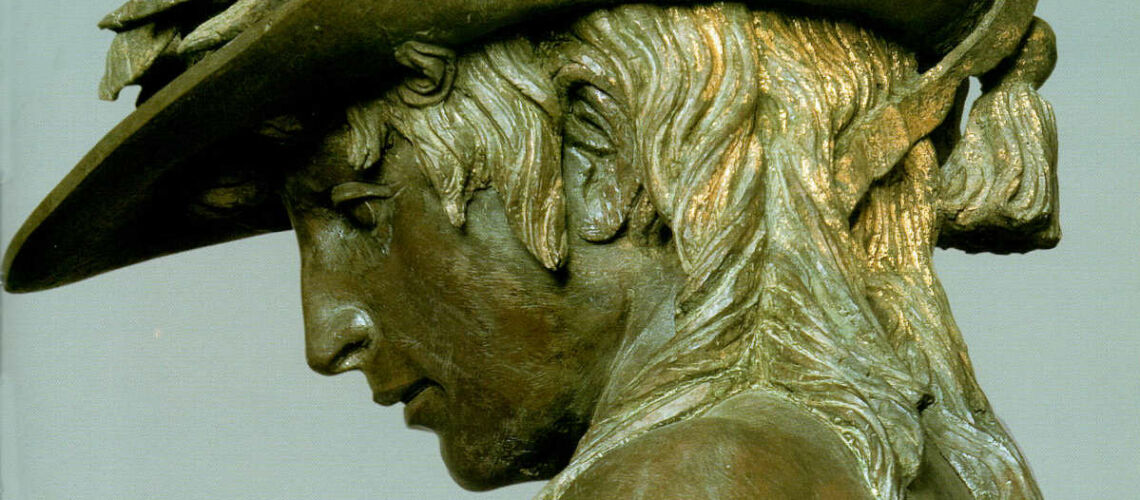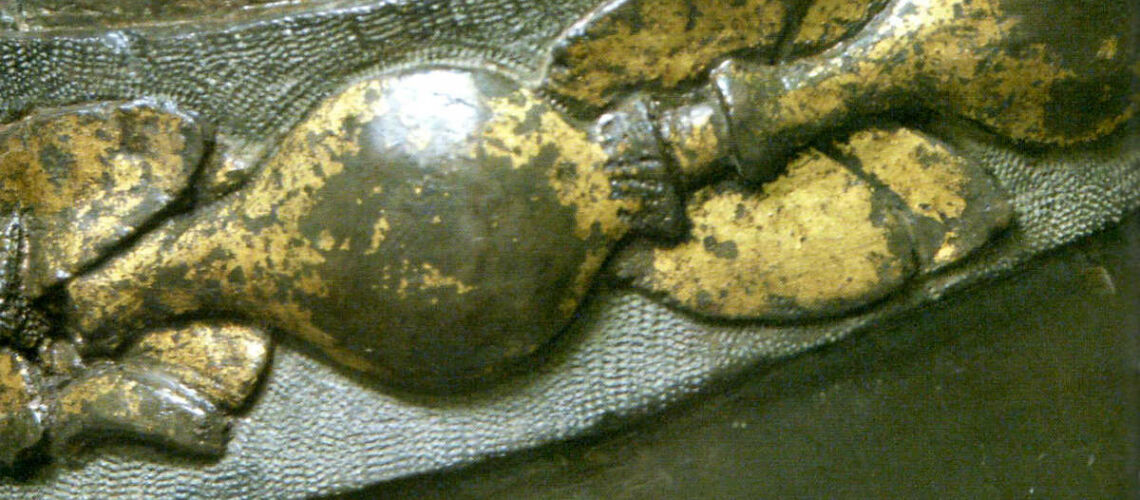The David by Donatello
It was Cosimo dei Medici the Elder who, around 1440, commissioned Donatello to create a bronze statue of David cast in lost wax.
In 1420 his father Giovanni di Bicci dei Medici, founder of the Banco dei Medici and great patron of art in Florence, left the management of his activities to Cosimo dei Medici the Elder, who was as skilled as or more than his father, enormously expanded the circle of business by opening branches of the Medici Bank in most of Europe. Politically shrewd, he managed to win the favor of the antipope John XXIII, and Pope Martin V who replaced him in 1417, requested a large loan from the Banco dei Medici, and Cosimo granted it to him: friendship with the current pope was very important for the Banco dei Medici.
| Giovanni di Bicci, Cristofano dell’Altissimo, 1562, Uffizi Gallery | Cosimo dei Medici il Vecchio, Pontormo, 1520, Uffizi Gallery | Papa Martino V, copy from Pisanello, Palazzo Colonna, Rome |
Upon the death of his father Giovanni di Bicci in 1429, Cosimo managed to create a pro-Medici party in the government of the city which was an enemy of the oligarchic faction headed by the Albizi through alliances and marriages with the great families such as the Tornabuoni, the Salviati, the Bardi, the Cavalcanti. He managed to appear pro-popular while simultaneously transforming the Medici family from nouveau riche to aristocracy.
Having failed in 1430 the plan of the oligarchic government of the Florentine Republic to have Cosimo exiled from Florence on various pretexts, due to the opposition of Niccolò da Uzzano, when Uzzano died in 1433 they managed to have Cosimo imprisoned by accusing him of wanting to become dictator of Florence.
Cosimo dei Medici the Elder, Pontormo, 1520, Uffizi Gallery
In prison he was isolated, but he bribed the warden Federico Malavolti who allowed him to warn his party which organized a popular uprising, and the oligarchic government of Rinaldo degli Albizi was forced to let him out, condemning him to exile from the city.
Cosimo with a crowd of friends and servants stopped in Venice, where he lived as a great lord, controlling and directing the government of Florence: in 1434 he had a group of pro-Medicean rulers appointed who had him recalled to Florence; Cosimo in turn had his enemies exiled.
It was from the Palazzo Medici in via Larga, designed by Michelozzo, that he managed city politics, extorting his enemies with the taxman and always making sure that in the government of Florence there was a majority of men who strictly trusted him.
Palazzo Medici, Michelozzo, before the enlargement of the Riccardi, 1684, Del Migliore, Florence città nobilissima
Palazzo Medici, Michelozzo, circa mid-15th century, with the right side subsequently enlarged by two portals by the Riccardi
The bronze David was modeled and cast in bronze with lost wax method by Donatello around 1435-1440, before the artist was called to Padua in 1443 to sculpt Christ and the bas-reliefs for the altar of the Basilica of S. Antonio in Padua and then the monument to Gattamelata.
Portrait of Donatello, Paolo Uccello, Louvre
David by Donatello
It is assumed that it was placed in the great hall on the first floor (piano nobile) and in 1457 (or in any case before the arrival in Florence in 1459 of Galeazzo Maria Sforza hosted in the Palazzo and of Pope Pius II Piccolomini) it was brought to the courtyard of Palazzo Medici , which Cosimo was furnishing, and placed in the center on a red porphyry column probably salvaged and adapted from Rome, in turn resting on a white marble base sculpted by Desiderio da Settignano with four harpies at the corners. In David the thick bronze crown of oak leaves at the base framed the support of the bronze to the marble of the column.
A reconstruction of the base was made in fiberglass by the Bargello Museum and is the one shown here in the photographs
Galeazzo Maria Sforza, Piero del Pollaiolo, 1471, Uffizi Gallery
Pope Pius II Piccolomini, Pinturicchio, second half of the 15th century
Base reconstructed in fiberglass from the Bargello Museum for the exhibition at the Bargello of the original Donatello restored in November 2008
Bargello, replica photo of the Ferdinando Marinelli Artistic Foundry’s David di Donatello on the base reconstructed in fiberglass from the Bargello Museum for the exhibition at the Bargello of the original restored in November 2008
Bargello, foto di replica del David di Donatello della FAFM sulla base ricostruita in vetroresina dal Museo del Bargello per l’esposizione al Bargello dell’ originale restaurato nel novembre 2008
The height of about 160 cm of the bronze together with that of the base made it possible to reach a total height of about 3.5 meters. And in fact the work was created to be looked at from below. Gentile Becchi, an educator who lived in Palazzo Medici, dictated an epigraphic inscription that accompanied the David:
“Victor est quisquis patriam tuetur. / Frangit immanis Deus hostis iras. / En puer grandem domuit tiramnum./ Vincite cives!”
“Whoever defends his country is bound to win, / for God breaks the furious resolves of the most fearsome of enemies. / Here is the boy who defeated a huge tyrant. Citizens, to victory!” (Caglioti 2000, p. 205);
the epigraph makes David a heroic symbol of great political as well as moral strength. With the door of the building open, it was visible to all who passed in front of it (as Marco Parenti underlined in his letter of 1469 where he describes the marriage of Lorenzo the Magnificent to Clarice Orsini sent to Filippo Strozzi in Naples).
When the Medici were expelled from Florence in 1495, the Florentine Republic, which had requisitioned the family’s homes, took possession of their works of art in the Palazzo Medici, including the David di Donatello, which they transferred to the courtyard of the Palazzo dei Priori.
In 1511 the David was struck by lightning, and from that moment on he appeared and disappeared from the courtyard of Palazzo Vecchio: in 1555, when Duke Cosimo I and his family lived in the Palazzo Vecchio, the David was removed from the courtyard and was closed in a warehouse; it was replaced by the Putto with the Dolphin executed in bronze by Verrocchio taken from the Medici villa of Careggi, and was placed on the porphyry fountain created by Francesco del Tadda in the center of the courtyard.
The David reappeared with its column base in the courtyard in 1570 in a niche in the east porch, but in 1592 it was again removed and replaced by Pierino da Vinci’s Samson on the Philistine.
Until 1638 we do not know where it was, the year in which it appears, according to the inventories of Palazzo Pitti, in the Sala Bianca. It then reappears when it is transferred in 1778 to the Uffizi gallery.
Finally in 1865 it was housed in the Bargello, transformed into the National Museum and here it stopped.
David is a naked youth with one foot on the severed head of the Giant Goliath. The naked body is flaunted in the attitude of a winner; he wears a laurel-wreathed Mercury-like brimmed hat with a lost plume cap; at his feet he has ancient-type footwear, in his right hand he holds a large flat-pointed sword that rests on Goliath’s helmet, in his left a sling stone. Goliath has a winged helmet where a bas-relief appears on the visible side. David’s sword indicates precisely the small bas-relief which therefore probably highlights the “moral” of the entire sculpture. It represents a chariot pulled by two winged and naked putti; on the chariot is enthroned a wingless figure who receives gifts from two other winged putti; behind the throne appears a naked and fat character without wings who has an amphora at his feet. The scene seems to be taken from an ancient Roman gem, probably from the Medici collection; it is probable that the seated figure is Bacchus accompanied by Silenus, and that the winged putto is offering him a cup of wine. Being on Goliath’s helmet, it could be the representation of incontinence, pride and arrogance, vices associated with Goliath (and the tyrannical enemies of Florence) conquered by the virtue of David (the Republic of Florence, crypto-managed by Cosimo).
David by Donatello
| David by Donatello, detail of the headdress | David by Donatello, detail of the shoe |
David di Donatello, detail of right hand with sword
| David by Donatello, detail of the left hand with the stone | Donatello’s David, detail of the head of Goliath |
That it was placed high above the column is proven by many details: his head and gaze are turned downwards, the only way to be able to see his face, but also by a series of anatomical irregularities, such as the shoulder blades and lowered buttocks in the flattened and then broken backside and in all the angular joints that Donatello performed as an optical correction for the high placement of the statue, the strong rotation of Goliath’s head to make the plate with the cherubs visible, many unfinished parts that would have been hidden by the garland protruding on the base. Comparing the impression of David at eye level with the same place above, completely changes the grandeur and vigor of the character and the meaning of the helmeted head of Goliath.
David by Donatello, detail
| David by Donatello, before restoration | David by Donatello, after the restoration |
The David, which had been commissioned by a private individual, would be displayed so high in a private home, Donatello sculpted the nude David for the first time. His childhood, his sanctity, humility and warrior heroism would have saved Donatello and the client any suspicion of heterodoxy. Donatello was also inspired by classical sculpture, almost always nude. Only after a few generations, with Michelangelo, did another completely naked David appear.
The David is one of the less successful castings from a technical point of view: it has many cold-assembled plugs to correct the deficiencies, it has various cracks, parts which were not reached by the bronze during the casting, the need for remelting to reconstruct parts that did not come (clearly visible is the crown of the hat, the back of the helmet of Goliath, part of the base wreath, lack of fusion under the chin). The many movements of the statue have caused other damages probably also due to falls, such as the breakage and loss of a lock of hair on the left shoulder.
David by Donatello, detail
David by Donatello, detail
David by Donatello, detail
In a letter from Gentile Becchi, tutor in the Medici house and friend of Lorenzo the Magnificent, a fitting judgment appears on the type of work by Donatello:
…Contende la magnificentia con l’ utilità, l’ utilità chol p[iacere] et novità… ma perché l’ oficio mio con Voi è asuto più riprendere che lodare, un [man]camento vi viddi, et questo è quello hebbe Donatello et qualunque ha più inventio[n]e [e sa] bozzare più che finire, ordire più che essere patiente a tessere. (ASF, Mediceo avanti il Principato, XXXVII, 489)
And in fact Donatello took care of the final effect of his sculptures so that they gave the viewer the effect he had wanted, without wasting too much time on details and finishes, because he believed the rough and unfinished surface would have given greater strength and expressiveness to his works.
A very interesting detail is the cold scratching of a large part of the surface of the sculpture, probably to limit its reflections.
David by Donatello, detail
David by Donatello, detail
David by Donatello, detail
David by Donatello, detail
The hair, spared from the rain thanks to the visor of his hat, tells us that in many parts Donatello had highlighted some parts of the work with gold leaf (“a missione”), as he did for example in Attis.
David by Donatello, detail
Attis by Donatello, detail

